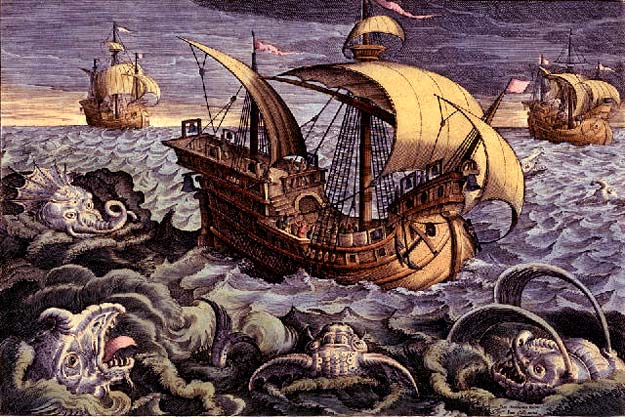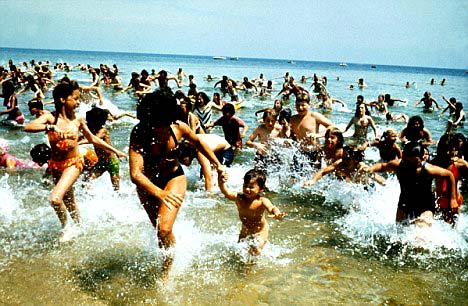From ancient times, in Western culture and worldwide, water has been an enduring theme in the arts. Water themes (including snow and ice) flow
Sea monsters in literature often are exaggerations of naturally occurring creatures. An enormous and “hostile” giant squid became a menacing foe in Jules Verne’s 1873 classic Twenty Thousand Leagues Under the Sea.
throughout literature, poetry, fine art, theater, music, and film. The images may be enduring, aesthetically appealing, or threatening in themselves; alternately, water (e.g., the sea) may be a metaphor for birth and rebirth, violence and death, self-discovery, spiritual journey, metamorphosis, change, inspiration, and renewal. The following discussion briefly highlights some components of water primarily within the Western arts, from ancient times to the present day.
Literature
Western literature was launched upon the waters. The Odyssey (together with The Iliad, epic Greek poems attributed to Homer, c. seventh century B.C.E. ) details the hero Odysseus’s perilous 10-year return across the sea from Troy. Centuries later, arguably the first English novel, Daniel Defoe’s Life and Strange Surprising Adventures of Robinson Crusoe (1719), vividly relates the life of a man marooned on a desert island, and thus the spectre of the everpresent ocean. Other notable English-language literary works with a water focus include Samuel Taylor Coleridge’s (1772–1834) apprehensive ballad, “The Rime of the Ancient Mariner.” The English translation of the French writer Jules Verne’s (1828–1905) Twenty Thousand Leagues Under the Sea had enormous popular appeal and anticipated many twentieth-century underwater technological and scientific achievements.
In North America, the tradition of writing about mankind’s adventures in the natural environment dates back to colonial times. James Fenimore Cooper (1789–1851) wove his experiences as a midshipman into stories of adventure on the high seas. Herman Melville (1819–1891) wrote several popular romances of life at sea before creating his symbolic and philosophical masterpiece Moby-Dick (1851) about an obsessive whaler’s hunt for a great white whale. Mark Twain’s (1835–1910) boyhood on the Mississippi River laid the groundwork for what has been called the first modern American novel, The Adventures of Huckleberry Finn (1884). This classic work centered on the adventures of a boy and a runaway slave who rafted down the Mississippi.
Contemporary Writers
Henry David Thoreau’s (1817–1862) journal of close observation of life at Walden Pond, Walden, or a Life in the Woods (1854), which has achieved iconic status, anticipated many major themes in contemporary American environmental writing. Henry Beston’s The Outermost House (1928) mused upon a year spent living alone off Cape Cod. Marjory Stoneman Douglas’s The Everglades: River of Grass (1947) became a classic exposé on environmental destruction in fragile swamps. Aldo Leopold’s poetic Sand County Almanac (1949) strengthened the early environmental case. Before publishing Silent Spring in 1962 (a book that went on to factor heavily in the launch of the modern American environmental movement), marine biologist Rachel Carson wrote evocatively in Under the Sea Wind (1941) and The Edge of the Sea (1955).
Other major works and modern classics of American nature writing that explore and challenge our relationship with the water environment include John Graves’s Goodbye to a River (1960), Wallace Stegner’s The Sound of Mountain Water (1969), Annie Dillard’s Pilgrim at Tinker Creek (1974), and Ann Zwinger’s Run, River, Run: A Naturalist’s Journey Down One of the Great Rivers of the West (1975).
Ice and Explorers
The human imagination and the arts have been inspired by water in both liquid and solid form. A rich body of literature exists based on high adventure to the far-distant frozen Antarctic. In 1816, Thomas Erskine’s novel Armata envisaged a utopian world in which a sister planet was attached to Earth by two navigable sea channels flowing in opposite directions from the South Pole. Many nineteenth-century works supported the “hollow Earth” theory, most notably and influentially Edgar Allan Poe’s The Narrative of Arthur Gordon Pym of Nantucket (1837). After Captain Robert Falcon Scott’s (1868–1912) ill-fated second expedition to the Antarctic, stories appeared based on whaling adventures, historic expeditions, science fiction, and murder–mysteries (e.g., Hammond Innes’ 1949 The Survivors, loosely based on Sir Ernest Shackleton’s 1914 expedition in which his ship, The Endurance, was crushed by ice). Since the 1970s, most Antarctic fiction deals with themes of worldwide catastrophe and survival, from war to under-ice volcanic eruptions and breaking ice caps.
Environmental Literature
Since the first Earth Day (April 22, 1970), environmental literature, as it often is called, has become a major genre around the world. Today’s environmental literature denotes a written work that investigates the relationship between people and nature. This may include oral readings, poetry, fiction, nonfiction, and drama.
Contemporary environmental writers such as Rick Bass, Wendell Berry, Alison Hawthorne Deming, Barry Lopez, Peter Matthiessen, Richard Nelson, Robert Michael Pyle, Scott Russell Sanders, Gary Snyder, and Terry Tempest Williams fundamentally link the literary arts with environmental awareness and responsibility, often rooted strongly in a sense of place and community. “A Call to Action: An Ecological Bill of Rights and Responsibilities” (Enviroarts, 1995) challenges the American arts community to forge a creative, national response to “erosion, poisoned water and air,” among other social and environmental threats.
Fine Art and Popular Art
In ancient art, water was often represented by stylized curvilinear forms, such as the spiral (as evidenced by the Minoans of Crete) or a horizontal zigzag (as found in the art of ancient Egypt). In the famed eleventh-century Bayeux Tapestry, the English Channel is represented by embroidered wavy black lines. Distinctive indigenous art components include “Oceanic Arts,” that is, the visual arts of the southern and northwestern Pacific Islands.
Rivers, lakes, and seas were once the great highways of the world, and much art shows water as a backdrop to everyday life. Royal barges are painted on the walls of Egyptian tombs dating to 1360 B.C.E. Ships and ports appear on medieval manuscripts and Renaissance frescoes. The brilliant Renaissance painter, sculptor, and inventor Leonardo da Vinci (1452–1519) was fascinated by water, which he described as “vetturale di natura” (the vehicle of nature). He drew it in detail, studied it closely, was in awe of its power (he had witnessed terrible floods and storms), and designed complex canal systems and locks.
A tradition of Dutch marine artists dates back to the seventeenth century, and led to the proliferation of professional marine artists in Britain. Of the French seascape painters, arguably the most significant was Claude Monet (1840-1926), whose oil-sketch Impression: Sunrise (1874), portraying
The riverboat era was romanticized by various painters in the nineteenth century. This print by Currier and Ives shows a Mississippi riverboat loading logs.
the harbor at Le Havre, gave its name to the Impressionist movement he founded. Monet went on to paint beach and river scenes in France and England.
The nineteenth-century Romantic tradition emphasized bold, dramatic paintings of nature—for example, seascapes by the English painter J. M. W. Turner (1775–1851), or dramatic events such as Théodore Géricault’s The Raft of the Medusa (1819) and its portrayal of despairing shipwrecked sailors. The Hudson River School (1835–1870) housed the first great school of American landscape painters, who produced romantic and naturalistic renderings of the landscape of the Hudson River Valley and beyond.
“Earthworks” or “land arts,” dating from the late 1960s and early 1970s, are works in which natural elements are directly employed or the landscape rearranged and the resulting artwork tempered by exposure to the elements. Robert Smithson’s Spiral Jetty (1970), a huge rock and salt crystal spiral created in the midst of Utah’s Great Salt Lake, is no longer visible beneath the rising waters.
Folk Art
The water world provides inspiration for folk art—art produced by mostly self-trained artists or for the preservation of traditional ethnic cultures—including functional and decorative hand-carved wildfowl and fish decoys, decorated sea chests, scrimshaw s , ship’s figureheads, and nautical ornaments. In America, the zenith of traditional folk art flourished in the nineteenth century prior to the rise of industrialization, but a rich contemporary tradition continues of naive, “outsider,” and “memory” artists. Traditional Vietnamese water-puppet performances continue a rich and ancient folk art theatre tradition, in which the puppeteers stand behind a screen in water up to their waists, with the floating bamboo water-puppet theatre occupying the middle of a pond.
Music and Song
The arts encompass the environment of sight, word, and sound. The aesthetics of sight and sound come together architecturally in decorative water fountains and in Frank Lloyd Wright’s famous house Fallingwater.
Popular “everyday” art involving water can find expression in unlikely places, such as elevated water towers. Even a fire hydrant can become a painter’s palette, as evidenced during a community-sponsored event in Oldenberg, Indiana.
Water-inspired classic compositions include works such as Debussy’s La Mer, Ravel’s Jeux d’eau, Mendelssohn’s Calm Sea and Prosperous Voyage and Hebrides Overture, Wagner’s Tristan und Isolde, and Handel’s Water Music. Traditional folk music often addresses water-related themes, whether the storytelling vehicle is a sea shanty, minstrel tune, or ballad.
Just as the arts recognize a visual landscape, the modern “soundscape” is the creative concern of AcousticEcology.org . This networking and resource information project focuses in part on human-induced environmental impacts on the oceans, and emphasizes “the art of soundscape production and . . . creative interpretations of the sounding world.” Ecological concern is also the driving force behind Musicians United to Save the Environment.
Film
Numerous academic studies investigate the linkages between mass media, popular culture, and societal attitudes and behavior towards the environment. In the movies, water has been a threatening environment, including one that shelters “hostile” creatures. Examples include the shark attacks in Jaws, the river itself in Deliverance, and the ocean in the fact-based The Perfect Storm. Water has been the setting for a post-apocalyptic world ( Waterworld ) or an otherworldly encounter ( The Abyss ).
Conversely, particularly in family films, the welfare of a marine animal may be the central focus, as in Free Willy, * Orca, and Tarka the Otter. Conservation of the water environment also may be a central theme, as in Turtle Diary and When the Whales Came.
Increasingly, a diverse assortment of films and videos explicitly address socioecological issues and perspectives. These are promoted and celebrated at annual environmental film festivals throughout the world: within the United States (e.g., the Hazel Wolf Environmental Film Festival, the Washington D.C. Environmental Film Festival, and the Cornell Environmental Film Festival); Canada (e.g., Planet in Focus); Africa (e.g., the African Environmental Film Foundation and Pretoria’s International Environmental Film Festival); Australia (e.g., Wild Spaces); and Europe (e.g., London’s Green Screen). Fine art and film may come together, such as with the acclaimed 2000 documentary, Rivers and Tides, which celebrates the art of Andy Goldsworthy.
Environmental Art
Just as there has been a shift in the role and spread of modern environmental literature since the early 1970s, so too is there a worldwide contemporary movement in environmental art, concerned with human relationship with the natural world. This may also be called eco-art, Art+Nature, or restoration art, and may extend to socially and politically oriented efforts known as “eco-activist art” and “environmental justice ecoart.” Examples include Soul Salmon, an “art action” movement of Northwest American artists, businesses, institutions and tribes to protect native salmon, and artist Deborah Small’s painted porcelain brick art statement to preserve Mono Lake in California that led to a landmark public trust law case. Eco-Art was represented at the 2002 World Summit on Sustainable Development in Johannesburg, South Africa, with a call for artists around the world to devote their next artwork to an environmental issue.
In the 1975 Steven Spielberg movie version of Peter Benchley’s novel Jaws, human characters battled a ferocious and malevolent shark. Real-life shark attacks are fairly uncommon, despite sensationalized media coverage.
Numerous illustrations and examples of environmental art abound within North America and internationally, and may be found by reference to organizations and websites such as Enviroarts: Orion Online; Greenmuseum.org , a collaborative online museum of environmental art; and Eikon, an online resource created by Artecology. Art Culture Nature, an association for the study of the arts and the environment, is an interdisciplinary organization founded in 1997, whose mission “brings together artists and teachers in the fine and performing arts as well as environmentalists and educators in the humanities, sciences and social sciences who are interested in the study of the connections between the arts and environmental studies.” The Association for the Study of Literature and the Environment provides links to many related environmental arts organization and electronic archives.
Conclusion
Like water itself, the arts are not fixed, but fluid and constantly evolving and responding to change. The arts are also an ideal means by which humans explore, understand, communicate and challenge their culture, values, and ethics. The response to art may have philosophical, ecological, social, or political implications upon how societies and individuals live as an integral part of this water planet.




